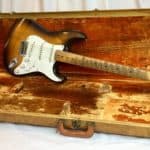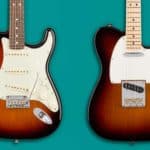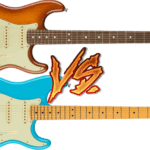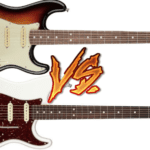When it comes to Pre CBS era Fenders, it’s all about the nostalgia, the scarcity, and the mythology around these Guitars.
Regardless of differing opinions on these guitars, one thing is for certain, they’re extremely popular and sought after among guitar enthusiasts.
The reason pre-CBS Fenders are considered to be better is that at the time Fender was just starting and they took a very hands-on approach to the building of their guitars. The CBS period brought about a decline in the quality of the brand, despite the existence of great guitars from the era.
Pre CBS guitars set the music standard back in the day, being played by the likes of Keith Richards, Eric Clapton, and a whole assortment of rock icons.
It’s still common today for rockstars to take a relic from the past and hold it in high esteem and that has no doubt influenced the majority of people to think similarly.
There was a certain magic to the pre-CBS guitars though.
What was the CBS era of Fender guitars?
1965.
This was the year that marked the single most important change in the history of Fender.
This was the year that the management of Fender transferred to the CBS corporation which had purchased the company from Leo Fender for 13 million dollars.
Everything made by Fender before 1965 is considered pre-CBS era and is seen as far more desirable to guitar collectors.
The CBS era marked a shift to a more mass-produced style of guitar making within Fender and the stretch from 1966 to the early ‘80s is considered the true CBS era and the low point of Fender quality.
So what changed?
New Pickguards Materials
From 1954 to 1959, most Fender guitars and basses used a pickguard made of a single piece of celluloid. Starting in 1959, most Fender Pickguards consisted of three layers of celluloid with the top layer having a greenish hue.
In 1965, the switch was made from celluloid to ABS or Vinyl; these guards are considered to be far less attractive by most collectors.
Shape changes
The Stratocaster, introduced in 1954, set a precedent for a sleek body design that would carry through the Jazzmaster, Jazz Bass, Jaguar, and many other guitars.
The smooth, sporty curves set Fenders apart from many other guitar builders, but as CBS took further control of the production line, the shape of most Fenders became noticeably less curvaceous as another result of the more mass-production focused corporate approach taken.
Polyurethane Lacquer
Since the CBS Era, polyurethane has replaced nitrocellulose as the primary finished use on Fender instruments.
While some earlier Fenders had already used poly, as the CBS era went on, it was increasingly made the standard. The reason polyurethane is considered by some to be less desirable is because it’s thicker than nitro and generally has a heavier gloss.
Changes to the Dot Inlay Markers
One of the earlier changes made by the CBS purchase of Fender was a switch in the material used for fingerboard inlays. Starting as early as late 1964, Fender fingerboards were inlayed with Pearloid dots where previously they had used clay.
Later Changes Under CBS and their Legacy
CBS’s changes did not end with the ‘60s, rather a series of major design changes continued through 1971, including a switch to a three-bolt neck-plate, replacing the earlier four-bolt version.
Another change made in ‘71 was to the bridges and saddles of Fender, opting for cheaper, heavier designs.
Overall, CBS’s design choices were implemented to reduce production costs as much as possible. However, their legacy wasn’t all bad.
There were some outstanding models made by Fender during the CBS that have become idols in their own right.
CBS ownership lasted until 1985 when the company was sold to a group of Fender employees led by Bill Schultz.
Why are pre-CBS Fender guitars considered better instruments?
Back when Fender was starting out, the materials used in the building of their guitars were considered to be of a higher quality than the materials used during the CBS era.
The fact that many pre-CBS era Fenders were also hand-made also meant that there were fewer of them made in comparison to the mass production of later models.
You would also find that within lines of the same guitar model, different instruments might have unique, minor differences.
Overall, the rarity of these guitars and the materials used is what has led many collectors and guitar enthusiasts to consider these guitars as better than any CBS-era Fender models.
Not to mention that many Fender enthusiasts loathed the CBS era of Fender guitars.
What about post-CBS Fenders?
The transition to post-CBS was a difficult transition for Fender to say the least.
At the time CBS had begun positioning itself to shut down Fender guitar production due to the crash in the music market in the ‘80s.
When Bill Schultz and his team bought back the company, they originally intended to produce a few American-made models but mostly continued to use Japan as their main source of production.
Things didn’t go to plan, but despite the challenges faced by the new ownership of Fender, they managed to rebuild Fender’s reputation over the next few years.
Adding innovations to their guitar designs and slowly growing the size of their American factory, Fender has built up their name to be even more widespread than they were in the golden age of guitar.
It can be said that there is no perceptible difference between modern Fender models and pre-CBS models.
Some models are better overall, regardless of their era and this is typical among mass-produced instruments.
It’s also important to consider that early instruments didn’t benefit from computer-based equipment used nowadays to produce the bodies and parts.
Whether it’s a plus or not that modern-day Fenders are made with computer-generated accuracy as opposed to hand-made craftsmanship is a matter of opinion.
Check out a more in-depth discussion here:
How do actual Fenders stack up to CBS Fenders?
In my opinion, unless you’re going to nitpick, the CBS Fenders don’t sound bad, even when compared to modern fender models.
They have a different sound to the Pre-CBS models, a little less full and warm, a little brighter and thinner, and their feel differs for sure, but as far instruments go, a lot of it can be a placebo effect.
Here’s a sound comparison:
I believe that bar a few really cheap guitar brands, it’s better to focus on your playing than to blame your guitar for not having just the right sound.
It’s far too easy to say that if only you had that special, rare guitar as your idol does, then you’d also be an amazing guitar player, but music is in the hands of the musician more than anything else.
Are all CBS Fenders horrible?
Probably not. I’m sure you can find great CBS-era instruments if you can cope with their specs.
The big headstocks and 3 bolt necks are a turn-off for many players, but there were some stand-outs.
The semi-hollow body Thinline Telecaster is one example that launched during CBS’s reign.
The Coronado and Starcaster models were also launched during this period, among other guitar models.
Then why do players hate that much on CBS Fenders?
I think it’s probably an exaggeration. But I can see how many feel that the taking over of a big corporation destroyed the traditional values of the brand.
Nobody has ever been a fan of large, faceless companies mass-producing a once loved object and I think everyone appreciates personalized craftsmanship.
For many fans of the Fender brand, it’s more about the nostalgia and the fact that some great rock idols played Fenders.
Fun Fact, the reason that Fender named their early model in the ‘50s the Telecaster was because of Television.
Television was the obsession at the time, so it was pretty smart of their marketing to rhyme their new guitar with the new craze.

Hello there, my name is Ramiro and I’ve been playing guitar for almost 20 years. I’m obsessed with everything gear-related and I thought it might be worth sharing it. From guitars, pedals, amps, and synths to studio gear and production tips, I hope you find what I post here useful, and I’ll try my best to keep it entertaining also.





